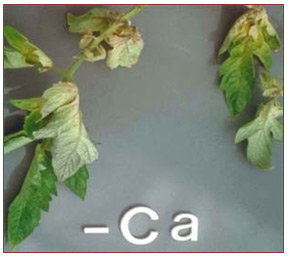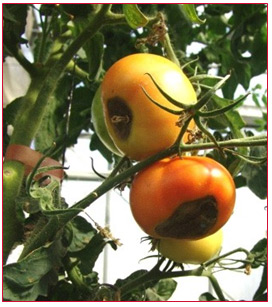
 |
| If you see a dark, rotting spot on the bottom of your tomatoes, it’s blossom-end rot. This problem, caused by a calcium deficiency, can be solved a few ways. |
All these symptoms show soft dead necrotic tissue at rapidly growing areas, which is generally related to poor translocation of calcium to the tissue rather than a low external supply of calcium. Plants under chronic calcium deficiency have a much greater tendency to wilt than non-stressed plants.
Required calcium in tomato plants
Calcium is required in relatively large amounts. In total around 152lb/ac of calcium is taken up by a filed tomato crop yielding around 44.6t/ac. As calcium is needed during the whole growth period and its transport into the fruits is slowly, it is common practice to use applications throughout the season to build up levels in the crop tissue and again during fruit maturation, maximizing quality potential and storability.
Role of calcium in tomato plants
Calcium is a key component of cells holding the structure of cell walls and stabilizing cell membranes. It also has a direct influence on the salt balance within plant cells and activates potassium to regulate the opening and closing of stomata to allow water movement from the plant.
Calcium enhances pollen germination; regulates some enzyme systems; and influences the growth and health of cells and conductive tissues. It has a key specific influence on tomato fruit quality especially Blossom End Rot (BER).
Calcium is required for growth and yield and promotes the earliness of fruit development.
Establishment - Boost root and leaf growth
Vegetative Growth - Maintain vigorous plant growth
Flowering – Fruit Set Maximize crop reproductive development
Fruit Ripening - Maturity Maintain good fruit firmness and quality and reduce BER risks
Vegetative Growth - Maintain vigorous plant growth
Flowering – Fruit Set Maximize crop reproductive development
Fruit Ripening - Maturity Maintain good fruit firmness and quality and reduce BER risks
Causes of calcium deficiency (blossom-end-rot)
Symptoms
Blossom-end rot is most common when the growing season starts out wet and then becomes dry when fruit is setting. Damage first appears when fruits are approximately half their full size. The water-soaked areas enlarge and turn dark brown and leathery. These areas will eventually begin to rot, so the fruit should be picked and discarded.
Several factors can limit a plant’s ability to absorb enough calcium for proper development. These include: fluctuations in soil moisture (too wet or too dry), an excess of nitrogen in the soil, root damage due to cultivation, soil pH that’s either too high or too low, cold soil and soil high in salts.
The most obvious deficiency symptom is BER. However, deficiency results in scorching of the new growth and death of the growing point in both the roots and shoots. The leaves of seedlings become distorted and develop yellow, brown or purple necrotic areas starting at the leaf margin and moving into the interveinal areas. The growing point soon dies. In mature plants, the edges of the youngest leaves become brown, and some interveinal areas turn yellow. The growing point dies and the flower buds fail to develop. In the field, BER is more frequent on acid soils and those with a high salt content and can also cause vascular breakdown at the base of the plant, leading to wilting. It is prevalent under low soil moisture conditions. Crops grown on calcareous soils will also need calcium, as the element is not necessarily plant available due to its low solubility. Where calcium is supplied in excess, magnesium and potassium deficiencies may arise as a result of nutrient imbalance.
Prevention and control
The best way to see if there is a pH problem or calcium deficiency in the soil is to get a soil test done. The best pH for tomato is 6.0-7.0 and if it's already there, you don't want to add lime which will raise the pH. A mulch can help the soil retain moisture. Other tips include not planting the tomatoes when the soil is too cool (affects early fruits), don't overfertilize with nitrogen, and be careful not to injure the roots if cultivation is needed near the plants. Some sources recommend calcium chloride sprays on the foliage but use caution with these. They can cause plant injury and some reliable sources say they don't really help.
Start now by testing the soil
Although most vegetables do well with a soil pH of 6.2 to 6.8, for those with blossom-end the pH should be 6.5 to 6.8 to free more calcium in the soil chemistry. Test results will indicate the amount of lime to add. Even better, lime also contains calcium. Work the lime into the top 12 inches of soil. Use a lime labeled “fast-acting,” which is better than ground limestone unless you have weeks to wait for the lime to react in the soil. If the pH is already correct, the soil test will recommend a different calcium source, such as gypsum. Also, add crumbled egg shells to your compost or bury them in your garden over time to help maintain the calcium levels.
Don’t over-fertilize
Don’t over-fertilize
Too much nitrogen during early fruiting, especially with nitrogen made from ammonia, ties up calcium in the soil chemistry.
Avoid moisture stress
Avoid moisture stress
Use mulch to keep the soil evenly moist. Vegetables need about 1 to 1 1/2 inches of water a week while fruiting. The best way to water tomatoes planted in the ground is with a soaker hose. In hot climates it is especially tricky to keep big tomato plants in pots watered well during the summer. Make sure to water them daily or set them up on a drip system with a timer.
As a stop-gap measure, spray tomato plants with a calcium solution made for blossom-end rot
As a stop-gap measure, spray tomato plants with a calcium solution made for blossom-end rot
Follow label directions. Apply two to three times a week, beginning when the first blooms appear. This is not a long-term fix, but it may salvage your crop until you can take the steps mentioned above. The spray seems to work better on tomatoes than other vegetables.
Tidak ada komentar:
Posting Komentar